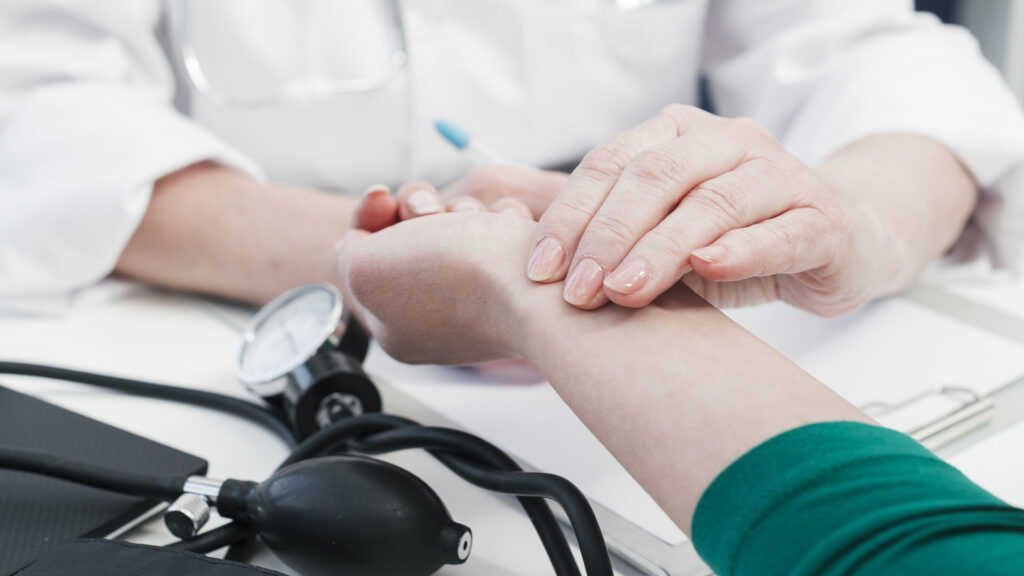Our practice remains open throughout the summer holidays. Appointments can be scheduled as usual.
With rising temperatures in spring, tick activity increases significantly. Due to fewer frost days, ticks now exhibit heightened winter activity as well. This results in a nearly year-round risk of transmission of TBE (tick-borne encephalitis), Lyme disease, and other pathogens. Interestingly, TBE cases are almost always associated with larger river systems—a phenomenon that remains unexplained to this day.
Our district has long been one of the high-risk areas for TBE in Bavaria. Each year, between 240 and 260 new cases are reported in Bavaria. The actual number is likely much higher, as 70 to 95% of infections are either asymptomatic or do not progress to the second stage of the disease, which involves meningitis.
Unfortunately, unlike bacterial Lyme disease, no specific treatment is currently available for the viral TBE.
Ticks carry the TBE virus in their saliva, meaning transmission can only be prevented if the tick is removed before it attaches. This makes protective vaccination particularly important for at-risk individuals. Vaccination rates are highest among children and adolescents in Bavaria, but the overall vaccination rate is only around 22%.
The number of reported Lyme disease cases is significantly higher than TBE, with 3,000 to 4,000 cases annually in Bavaria in recent years. Borrelia, the spiral-shaped, metabolically slow bacteria responsible for Lyme disease, reside in the tick’s gut. Transmission is only possible if the tick has sufficient time to feed, typically several hours.
Over the past decades, there have been repeated attempts to develop reliable vaccines against Lyme disease. Currently, Valneva, in collaboration with Pfizer, is developing a vaccine designed to protect against all six variants of European Lyme disease. According to a press release from the companies in December 2024, the vaccine is planned for market launch in Europe in 2026.
The vaccine targets proteins on the surface of Borrelia bacteria. The resulting immune response can neutralize and eliminate Borrelia in the bloodstream. In vaccinated individuals, transmission from ticks to humans is also prevented by antibodies in the blood that destroy Borrelia in the tick’s gut. However, studies indicate that Borrelia in joints are only inadequately addressed by the vaccine. Therefore, the vaccine primarily protects against new infections, while antibiotics are more suitable for treating existing Lyme disease cases. (Source: RKI)
Deep vein thrombosis (DVT) not only causes a venous blockage in the legs, but the thrombus can partially or completely dislodge and travel to the lungs, resulting in a pulmonary embolism. Depending on the extent of the occluded pulmonary vessels, the heart must work harder against the resistance of the blocked vessels to maintain adequate lung perfusion and, consequently, oxygen supply to the body. This can lead to cardiac arrhythmias or acute heart failure.
To prevent further growth of the thrombus and promote its dissolution, anticoagulant medications are used. Available options include so-called NOACs (non-vitamin K antagonist oral anticoagulants) such as Apixaban and Rivaroxaban, low-molecular-weight heparin in injectable form, and the well-established Marcumar. Current guidelines favor NOACs due to their fixed dosing, lack of need for blood level monitoring, and availability in tablet form.
Apixaban and Rivaroxaban require an initial high-dose therapy for 7 to 21 days before transitioning to a maintenance dose. Dabigatran, Edoxaban, and Marcumar require at least 5 days of heparin bridging to achieve full efficacy.
The duration of treatment depends on the cause of the thrombosis. If the cause is identifiable and temporary, such as postoperative thrombosis, anticoagulation is typically prescribed for three to six months. Recurrent thromboses, active cancer, or genetically determined coagulation disorders, however, may necessitate lifelong treatment.
Bed rest for thrombosis, as practiced in the past, is no longer required. Compression stockings help alleviate symptoms (leg pain, tightness) and improve quality of life.
All health insurance providers offer Hausarztzentrierte Versorgung (HZV), or family doctor contracts. These provide benefits for both doctors and patients. Participation is generally free of charge.
Advantages of Family Doctor Contracts:
- The family doctor is the first point of contact for all health issues and ensures better coordination of treatment.
- Referrals to specialists ensure that all findings are centrally recorded, avoiding duplicate examinations and medication errors.
- Patients benefit from additional preventive examinations, such as an annual check-up.
Important Notes:
- By participating, patients commit to their family doctor for a certain period.
- As the right to freely choose a doctor is guaranteed by the German Constitution, patients can change their doctor at any time. Your family doctor’s practice will assist you in this process—when registering, simply select the “Change of Doctor” option.
This ensures optimal medical care!
A clinical study has shown that doctors are significantly more likely to suspect the presence of deep vein thrombosis (DVT) than it actually exists. The primary reason for this lies in the relatively nonspecific symptoms. Patients often report feelings of heaviness or tightness in the legs or swelling. These complaints can occur in a similar combination with many different conditions. Consequently, primary care diagnostics require a structured approach:
First, the family doctor assesses the likelihood of DVT using the so-called Wells Score. This tool calculates the probability of occurrence based on the following risk factors:
- Is there an active cancer diagnosis?
- Recent surgery or prolonged immobilization of the leg?
- Bed rest for more than 3 days or surgery within the last 3 months?
- Tenderness along the course of the deep veins?
- Swelling of the entire leg?
- Circumference of the affected leg more than 3 cm larger than the unaffected leg?
- Unilateral edema?
- Prominent superficial veins?
- Previous thrombosis or embolism?
Different versions of the Wells Score exist. The further medical approach depends on the number of questions answered positively:
If only one or none of the above criteria apply, D-dimers—clotting breakdown products in the blood—can be measured. If these are not elevated, thrombosis is unlikely and no further investigation is needed. If two or more criteria are met, the probability is already at least 55%. In this case, a compression ultrasound of the legs should be performed immediately. Not all thrombi are directly visible on ultrasound. Therefore, the doctor also compresses the vein with the ultrasound probe. If the vein is occluded by a thrombus, it cannot be compressed. Some thrombi are initially too small to be detected sonographically. Current guidelines therefore recommend a follow-up examination within one week to identify growing thrombi.
Thromboses occur in approximately 160,000 patients per year in Germany. The likelihood increases with age, reaching about 1% per year from the age of 70. The most common location is in the thigh and knee areas. Deep vein thromboses can serve as the starting point for a dangerous pulmonary embolism. The risk depends on the extent and location of the thrombus and ranges between 2.5% and 9%. Three main factors primarily contribute to the development of thrombosis. When multiple factors are present, the risk increases exponentially:
- Damage to the vessel wall, e.g., due to atherosclerosis or injuries
- Stagnant blood flow, e.g., prolonged bed rest, heart failure, or long-distance travel in cramped airplane seats
- Increased blood clotting tendency, e.g., oral contraceptives, post-surgery, cancer, or infections
These are collectively referred to as the Virchow Triad. However, the most significant risk factor is a family history of thromboembolism, which increases the risk by 250 times (compared to a 2- to 4-fold increase for long-distance travel).
Hypothyroidism affects approximately 4 million people in Germany, with women accounting for about 80% of cases. The likelihood of the condition increases significantly after the age of 50. A distinction is made between overt hypothyroidism, i.e., complete thyroid insufficiency, and a latent form, which is far more common and represents a precursor to thyroid hormone deficiency. Iodine is essential for the synthesis of thyroid hormones. The body strives to maintain thyroid hormone supply for as long as possible. In cases of deficiency, this initially triggers a growth stimulus in the thyroid. Prolonged deficiency can lead to autonomous areas (i.e., regions decoupled from the regulatory system, known as “hot nodules”), scarring (“cold nodules”), and, rarely, malignancies.
The most common causes of hypothyroidism include autoimmune diseases (Hashimoto’s thyroiditis), thyroid surgeries, radioiodine treatments, and congenital thyroid defects in children. Hypothyroidism caused by medications, chemotherapy, or other metabolic disorders is significantly rarer.
Symptoms of hypothyroidism may include rapid fatigue, lack of drive, constipation, unintended weight gain, and a depressed mood. Other indicative signs include dry skin, hair loss, cold intolerance, or a slow pulse. In older patients, the condition may develop gradually. In infants, prolonged hypothyroidism can lead to physical and mental developmental impairments.
For family doctors, the patient’s medical history, physical examination findings, and levels of TSH, fT3, and fT4 are crucial. In latent hypothyroidism, TSH levels are elevated, while fT3 and fT4 (the actual thyroid hormones) remain sufficient. At this stage, symptoms may still be mild. In overt hypothyroidism, fT3 and fT4 levels are also reduced. However, the size of the thyroid does not provide reliable information about its functional status.
Therapeutic options include iodide and the thyroid hormone L-thyroxine. The daily iodine requirement for adults in Germany is approximately 200 µg. Iodine deficiency-related thyroid enlargement without significant functional impairment can be treated with 200 µg of iodide per day. According to the DEGAM guideline (German Society for General Medicine), overt hypothyroidism is a clear indication for hormone replacement therapy, while in latent hypothyroidism with TSH levels between 4 and 10 mU/L, treatment should be considered on an individual basis. In contrast, for autoimmune (Hashimoto’s) hypothyroidism, guidelines clearly recommend hormone replacement.
Milk and other foods can reduce the absorption of L-thyroxine. To ensure reliable absorption, the medication should be taken with water at least 30 minutes before breakfast. After initiating replacement therapy, TSH levels should be checked no earlier than eight weeks. Once stable, follow-up checks are recommended every six to twelve months and can be easily performed by the family doctor.
Thyroid nodules are a common finding and are now detectable in nearly every second adult in advanced age, particularly in women. Fortunately, according to the latest study results, only 1.1% of these nodules are malignant. The reasons for the increasing prevalence include persistent iodine deficiency and improved diagnostic techniques. Nodules are often discovered incidentally during ultrasound examinations of the carotid arteries or CT/MRI scans of the neck. The likelihood of carcinoma increases with nodule size, reaching approximately 5–15% for nodules larger than 1 cm.
The medical treatment strategy depends on the size and characteristics of a newly discovered nodule. Carcinomas often appear irregular and/or calcified on ultrasound, in addition to increasing in size. Laboratory tests, radioactive markers (e.g., scintigraphy), and fine-needle aspiration are also available. In addition to assessing thyroid activity (TSH), tumor markers can be measured. These are proteins that are present in healthy individuals but are excessively produced by certain tumors.
Nodules smaller than 1 cm with an unremarkable appearance should be monitored by the family doctor every 12 months, while suspicious findings should be checked every 3–6 months. Nodules larger than 1 cm, those with a tendency to grow, or those associated with signs of hyperthyroidism should primarily be further evaluated by a specialist, with a referral to a nuclear medicine specialist being appropriate. If there is continued suspicion of carcinoma, a fine-needle biopsy can provide information about malignant cells. If the suspicion of carcinoma is confirmed or if a hyperfunctioning “hot” nodule is present, surgery becomes unavoidable.
In Germany, health insurance is legally mandatory, and every resident must have appropriate coverage. Choosing the right insurance can be challenging due to the variety of options available. A family doctor can assist you in determining which type of insurance best suits your needs. Whether statutory or private, your health insurance determines the services you can access and how much you will need to pay out of pocket.
Statutory health insurance is the preferred choice for many people as it offers comprehensive coverage. However, you should be aware that certain services may not always be covered. In some cases, you may need to take out additional private insurance. A family doctor can help you make the best decision based on your individual health needs and financial situation.
Furthermore, Germany offers special plans for families. If you have a family, you should ensure that all members are included in your health insurance. A doctor can assist you in selecting the best options for your entire family to ensure everyone stays healthy and receives the necessary medical care.
In Germany, many people place great importance on their health. There are numerous ways to improve your health status. Whether it’s choosing a family doctor or preventing illnesses, small but effective changes in daily life can have a significant impact on your quality of life. A new medical center often offers tailored health programs to help you maintain your well-being.
Healthy nutrition and regular exercise are the cornerstones of good health. However, regular check-ups with your family doctor are also crucial for early detection of diseases. The doctors at our new medical center provide comprehensive care that goes beyond treating acute conditions. They support you in prevention and help you achieve your health goals.
Don’t forget to pay attention to your mental health as well. Many doctors in Uffenheim offer not only physical healthcare but also support for mental health, which is particularly important during stressful times.
- 1
- 2










